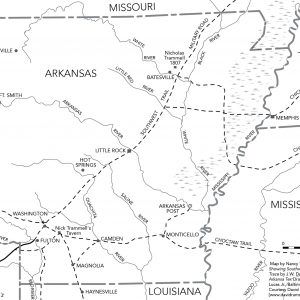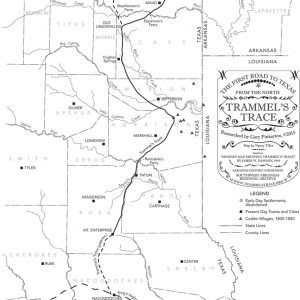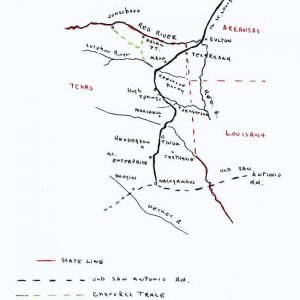calsfoundation@cals.org
Trammel's Trace
After the Louisiana Purchase in 1803, Americans from Tennessee, Kentucky, and Missouri moved down the Southwest Trail into Arkansas in search of land and opportunity. Crossing Arkansas diagonally from northeast to southwest, the Southwest Trail ended in U.S. territory at the Great Bend of the Red River, where Fulton (Hempstead County) was later founded. From that river crossing, Trammel’s Trace emerged as the first road from Arkansas into Texas from the north, terminating at the El Camino Real in Nacogdoches.
Named after Arkansas trader and horse smuggler Nicholas Trammell Jr., the route was a former Indian path that was adopted for smuggling horses as early as 1813. (The spelling of the name of the Trace with one “l” mirrors its most common appearance on the maps of the General Land Office.) As the first Anglo-Americans began to move into Spanish Texas, Trammel’s Trace from the north and El Camino Real (the Old San Antonio Road) from the east were the only routes into the territory.
Nicholas Trammell moved to the White River in Missouri Territory as early as 1807 to establish his trading activities. He moved to Pecan Point, in present-day Red River County, Texas, around 1818 and then followed the migration into Texas around 1822. He acquired a league of land at the Trinity River crossing of El Camino Real but, in 1826, was chased out of Texas as a result of land disputes in an incident that sparked the Fredonian Rebellion. He first used the trail that bears his name to smuggle horses through the Neutral Ground to Nacogdoches and then east across the Sabine River to the United States. Rather than capturing horses from the herds of wild mustangs that roamed the region, Trammell likely acquired them through illicit trade with Native Americans who captured or stole them from settlers and other tribes. Trammell was accused at various times of murder, plunder, and thievery, but much of the information surrounding him is myth and legend. What is documented is his long history as a trader, opportunist, and seeker of the challenge and reward of racing horses.
When waves of migration into Texas began after 1821, Trammel’s Trace became one of the primary routes to the colonies. Early Hempstead County records document the development of ferry services at Fulton and at Dooley’s Ferry farther down the Red River used for carrying immigrants from Arkansas into Mexican Texas. After the Texas Revolution in 1836, more direct roadways between established settlements began to replace the winding track. Even though Trammel’s Trace was little used at that time, Trammell guided troops down the trail from Washington (Hempstead County) during the Mexican War in 1846. Leaving Arkansas, the trail crossed present-day Hempstead and Miller counties. Some evidence of the old road still exists, but its path is largely lost to history due to land development.
In the 1940s, James and Mary Dawson researched the old road, and their research is being continued with more modern mapping tools. The Dawson collection can be found at the Southwest Arkansas Regional Archives at Historic Washington State Park.
For additional information:
“Address of the Cherokees to his Excellency Benjamin Howard Governor.” In Life and Papers of Frederick Bates. vol. 2. Edited by Thomas Maitland. St. Louis: Missouri Historical Society, 1926.
Jackson, Jack. “Nicholas Trammell’s Difficulties in Mexican Texas.” East Texas Historical Journal 38 (Fall 2000): 15–39.
James and Mary Dawson Collection. Southwest Arkansas Regional Archives, Washington, Arkansas.
Jones, R. L. “Folk Life in Early Texas: The Autobiography of Andrew Davis.” Southwestern Historical Quarterly 43 (October 1939, January 1940): 161.
Myers, Robert. “Nick Trammell: The Making of an Old Southwest Legend.” Arkansas Historical Quarterly 74 (Winter 2015): 352–378.
Pinkerton, Gary L. Trammel’s Trace: The First Road to Texas from the North. College Station: Texas A&M University Press, 2016.
Trammel’s Trace Preservation Society. http://www.trammelstrace.org (accessed August 26, 2023).
Gary Pinkerton
Houston, Texas
 Southwest Trail
Southwest Trail  Trammel's Trace
Trammel's Trace  Trammel's Trace Map
Trammel's Trace Map 



Comments
No comments on this entry yet.